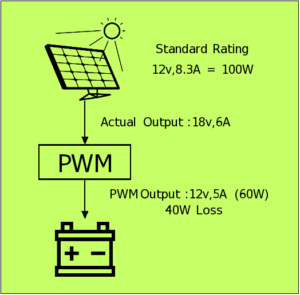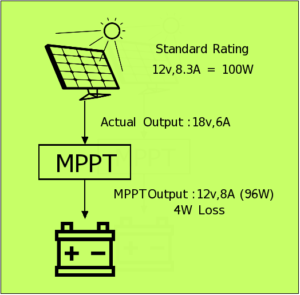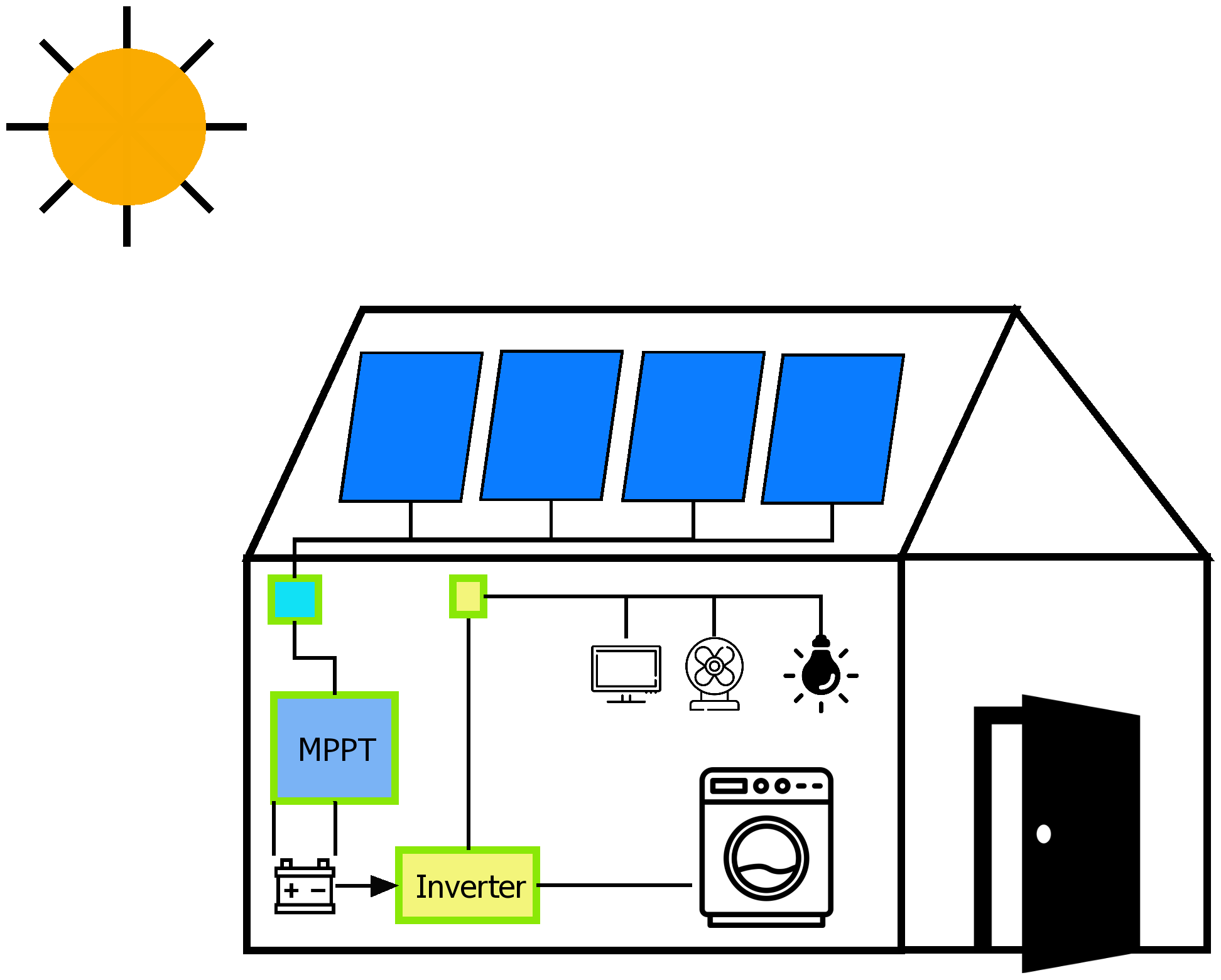What is Solar Energy ?
Solar energy is refers to converting energy from the Sun into electricity. There are number of solar cell which help to generate the electricity energy into it.
How Solar Cell Works ?
A solar cell is made numbers of photo voltaic cell .A photo voltaic cell is silicon crystals are laminated into n-type and p-type layers, stacked on top of each other. Light striking the crystals induces the “photo voltaic effect,” which generates electricity. It generated DC Powered by which we convert into commercial use.
Efficiency of a Solar Panels
A solar panel with 20% efficiency and an area of 1 m2 will produce 200W at standard test condition. If heat is more its produce upto 230-250W per 1 m2.
Why its Call free Energy of Power Source
The Sun is the largest source of free energy available on this planet. There are Photovoltaic cells, which are commonly called “solar cells”. The advantage of solar cells is that they can produce electricity directly from the Sun. The disadvantage is that when the Sun goes down at night, solar cells don’t produce any energy.
You just have Solar Panel + Charge Controller + Battery + Inverter + Any load like Bulb.
One Time Investment to buy, installation. and you maintenance the regular basics.
How to implement Solar Energy at Home or office
Requirement to Build a renewable Energy.
- Sun Light Space
- Any Solar Panel
- Charge Controller
- Battery
- Inverter
1. Sun light Space
Any space where yours sunlight is available at day & it not use for others use like waste area. At 80-90Sq Feet Area / 1KW for Solar Panel.Solar panel fixed at one place direction to sun.
2. Type of Solar Panel
- Monocrystalline
- Polycrystalline
- Thin-film
See Comparison About Poly crystalline, Mono crystalline & Thin-film Solar Panels
Do or Don’t With Solar Panels
Do
- Regular maintenance and cleaning is important.
- Remove the dust from Solar panels after dust wind weather.
Don’t
- Avoid physical damage (e.g. trees and bushes blowing in the wind and creating scratches).
- Avoid the surface from scratches its decrease the performance.
- Avoid the lose connection.
- Avoid the short-circuit the solar panels.
3. Charge Controller
There are two different types of solar charge controllers are PWM and MPPT charging methods to charge batteries from a solar array/panel. Both technologies are widely used in the off-grid solar which used by the efficiently to prevent over changing or over voltage from solar panels. Since panels in solar street lights need to be charged, these solar charge controllers are essential for a long-lasting, best-quality installation.
1. PWM (Pulse Width Modulation)
Pulse-Width Modulation (PWM) is help to charge the battery from energy generated by solar panel. During charging the controller allows as much energy from solar panel/array can generate Pull-Down voltage and no change in current and transfer to battery as near the standard charging rating of the battery to ensure that the battery is properly charged.

- As the diagram standard of Solar Panel 100W genrated 12v around 8.3A energy.
- In actual it produced around 18v , 6Amp energy.
- PWM can drop down the voltage 18v to 12v and no change in current.
Due to the nature of their work mechanism, PWM charge controllers cannot use the maximum power produced by the PV system and so their efficiency is low and around 80%.
2. MPPT (Maximum Peak Point Tracking)
Maximum Power Point Tracking is help to charge the battery from current generated by solar panel. It is indirect connection includes a DC/DC voltage converter that can take excess PV voltage and convert it into extra current at a lower voltage without losing power.

- As the diagram standard of Solar Panel 100W generated 12v around 8.3A energy.
- In Actual it Produced Around 18v , 6Amp Energy.
- MPPT can drop down the voltage 18v to 12v and left 6v convert to ampere.
Due to the nature of their work mechanism, MPPT charge controllers can use the maximum power produced by the PV system and so their efficiency is High and around 94% to 97%.
See Comparison About PWM And MPPT Charge Controller
4. Battery
- Lead Acid Batteries
- Maintenance Free batteries
- Tubular Batteries
- Solar Battery
1. Lead Acid Batteries
Lead acid batteries are the most commonly used in the backup power like UPS (uninterruptible power supply or uninterruptible power source), because it has higher cell voltage. These batteries are rechargeable in nature and produce large amount of current. The Lead acid battery which uses sponge lead and lead peroxide for the conversion of the chemical energy into electrical power, lead acid batteries are used in the non-portable appliances due to its heavy size and its required regular maintenance to fill distilled water on cells by checking electrolyte level when drop down its means you need to fill distilled water on cells. It mainly used in vehicles, inverter, solar-panel energy storage devices, etc.
2. Maintenance Free batteries
Maintenance free batteries completely sealed, and maintenance free, no need to maintain water levels.12 volt sealed lead acid batteries are extremely popular in backup power supplies, like UPS units, Wheelchairs, Car, Bike , Scooter and Alarm systems. They are fit and forget type batteries are safer compared to normal lead acid batteries. But they are costly compared to normal lead acid batteries and have a shorter life.
A SLA (Sealed Lead Acid) battery can generally sit on a shelf at room temperature with no charging for up to a year when at full capacity, but is not recommended. Sealed Lead Acid batteries should be charged at least every 6 – 9 months. A sealed lead acid battery generally discharges 3% every month.
3. Tubular Batteries
Tubular batteries are the most popular and efficient inverter batteries.It is identify easily by tall design ,in the Tubular plate battery is made up of negative plates like in flat plate battery except the positive part is made up of spines put under tube packets. Which cause very less wastage of current. Tubular battery has high efficiency, longer operational life (8+ years) and medium maintenance like check the level of electrolyte level if its goes down then it required to fill the distilled water. Because of so many advantages they are costly.
4. Solar Battery
Solar Battery is very Special C10 rating type of battery which only design for energy storage form solar, wind and other renewable energy systems. It is designed to be charged from Solar panels in the day from sunlight. The main component of battery is the lead inside. Higher lead ensures better battery performance and quality. Solar battery is a deep cycle battery is capable of surviving prolonged, repeated and deep discharges which are typical in renewable energy systems that are “off grid”. Batteries that can be frequently discharged down to such a value (at least 50% or even 80%) are called ‘deep-cycle’ batteries and are intended to use in solar power systems. It is very useful if you want to use an independent Electricity in house or office. Life Span upto 8-10 years and it requires Maintenance filling distilled water top up once in 3-6 month.
5. Inverter
An power inverter, or inverter, is an electronic device or circuitry that converts a direct current (DC) to alternating current (AC). Its similar like AC Current which works on a regular wall outlets. The alternative current can be of any voltage with the help of proper transforms. The inverter performs the opposite activity of a rectifier it inverted the DC to AC. An alternating current is required to run heavy appliances like Light Bulb,Fans,Tv,Refrigerators,Computer,Printers,etc
The input voltage, output voltage and frequency, and overall power handling depend on the design of the specific device or circuitry. The inverter does not produce any power itself,it produce the power is provided by the DC source.Which use in the form of AC Current.
Thanks for Supporting I Wish You Like Our Content, Please Comment Down for Any Query on this Comment Below.
